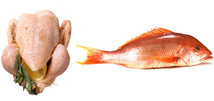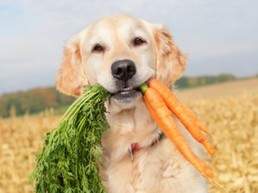
By Aubrey Bowen, SJAA Volunteer
There are so many choices out there when it comes to dog food. Whether you're in a grocery store, a big box pet store, or a pet supply boutique, you're faced with a wall of different food options.
Here's the first step to choosing a quality food: READ the ingredients and KNOW what you're looking for. We realize that's kind of a two-fold deal. Knowing what you're looking for involves a little bit of light research.
There are so many choices out there when it comes to dog food. Whether you're in a grocery store, a big box pet store, or a pet supply boutique, you're faced with a wall of different food options.
Here's the first step to choosing a quality food: READ the ingredients and KNOW what you're looking for. We realize that's kind of a two-fold deal. Knowing what you're looking for involves a little bit of light research.

Most importantly, you want a food that has clearly named meat. We're talking well-defined, pure, basic protein like chicken, turkey, fish, duck, lamb, beef, etc. What you don't want to see when it comes to proteins: by-products, animal digest, or meat meals. What does that stuff mean, anyway? It means animal garbage. By-products and unspecified "meat meal" includes the stuff we throw away like hooves, beaks, bones, and entrails [note: named meals are okay, like duck meal or salmon meal]. We don't want our dogs eating roadkill. It's gross and just really not healthy. The first two or three ingredients should be basic meats.
Fat is an essential part of a balanced dog diet. Dogs get most of their energy from fat, unlike humans. No "rendered fats" allowed! Look for named fat sources like salmon oil, chicken fat, etc. That's a pretty easy one.
Fat is an essential part of a balanced dog diet. Dogs get most of their energy from fat, unlike humans. No "rendered fats" allowed! Look for named fat sources like salmon oil, chicken fat, etc. That's a pretty easy one.

Next up: complex carbs. Now, here's where it gets a little tricky. Carbs aren't bad! Having said that, some are better than others. Look for whole grains like barley, oatmeal, rye, and brown rice instead of corn and flour. By-products and corn are the dastardly villains of pet foods. If you're looking for grain-free food because your pet has allergies or because you believe that's the absolute best way to go, you want to look for alternative carbohydrate sources. So instead of barley and oats, you'll look for flaxseed and potatoes. To make life easier, grain-free pet foods are typically labeled as such. They also tend to cost a little more, but we'll get to that in a bit.

Moving on: pets need their fruits and veggies, too! This one's the easiest yet. Just make sure there are a few different plain old fruits and vegetables listed that you recognize and would eat yourself. Spinach, carrots, peas, apples, potatoes, berries, and pumpkin are some common examples. You also want to see some good vitamins listed. A, B, D, nutrients like omega-3, biotin, and glucosamine are all great.
Here's where it gets a little controversial. At the end of the day, nobody wants to say they like chemicals. The fact is, they're really useful and we need them for certain things. Don't worry if you see some long funky names on the label. They're preservatives. Without these, your food would expire way too quickly. On the flip side, some chemicals really should not be used in pet foods and can have harmful side effects. So if you're concerned about the "-ates", "-ides", and "-enes" listed on your pet food label, pick the one that has the fewest. If you're following the rest of these guidelines, odds are that bad chemicals won't be an issue in the food you choose.
Here's where it gets a little controversial. At the end of the day, nobody wants to say they like chemicals. The fact is, they're really useful and we need them for certain things. Don't worry if you see some long funky names on the label. They're preservatives. Without these, your food would expire way too quickly. On the flip side, some chemicals really should not be used in pet foods and can have harmful side effects. So if you're concerned about the "-ates", "-ides", and "-enes" listed on your pet food label, pick the one that has the fewest. If you're following the rest of these guidelines, odds are that bad chemicals won't be an issue in the food you choose.

Although it can be tough to stomach the cost, spending more money on a high quality dog food pays off in the long run. Low quality food results in higher vet bills, gassier pets, weight problems and skin issues.
For the best of the best, you’ll see across the board that Orijen, Acana, and Wellness Core score the highest. These are fantastic foods that come in a wide range of wholesome varieties. BUT! It’s not all about brands and it’s not all about price. Don't be fooled into thinking that you've got to have a money tree in order to afford good pet food. There are some hidden gems out there in the pet food world that have both good quality ingredients and palatable sticker prices. Chicken Soup for the Pet Lover's Soul runs about $40 for a thirty-five pound bag. That's really good; it's not grain-free, but it doesn't have any sketchy ingredients. AvoDerm is a wallet-friendly grain-free choice. Depending on which protein you select (fish generally costs more than chicken), you can get a twenty-five to thirty pound bag for $40-50. A lot of folks dismiss Merrick because they label their foods with silly names like Turducken, Thanksgiving Dinner, and Wingaling. Merrick is actually a really nutritious, affordable, and palatable food. Canidae is another great quality, mid-budget, grain-free food. With independent companies like Canidae, you can rest easier knowing that you’re getting a cleaner, more consistent product in every bag than those generated by big-box brand food companies.
For the best of the best, you’ll see across the board that Orijen, Acana, and Wellness Core score the highest. These are fantastic foods that come in a wide range of wholesome varieties. BUT! It’s not all about brands and it’s not all about price. Don't be fooled into thinking that you've got to have a money tree in order to afford good pet food. There are some hidden gems out there in the pet food world that have both good quality ingredients and palatable sticker prices. Chicken Soup for the Pet Lover's Soul runs about $40 for a thirty-five pound bag. That's really good; it's not grain-free, but it doesn't have any sketchy ingredients. AvoDerm is a wallet-friendly grain-free choice. Depending on which protein you select (fish generally costs more than chicken), you can get a twenty-five to thirty pound bag for $40-50. A lot of folks dismiss Merrick because they label their foods with silly names like Turducken, Thanksgiving Dinner, and Wingaling. Merrick is actually a really nutritious, affordable, and palatable food. Canidae is another great quality, mid-budget, grain-free food. With independent companies like Canidae, you can rest easier knowing that you’re getting a cleaner, more consistent product in every bag than those generated by big-box brand food companies.

So where can you find top notch food for your furry friend? It’s not difficult! San Jose has some great local stores like Sam’s Downtown Feed, An-Jan Pet Supply, and Unleashed by Petco that offer a fabulous variety of pet foods. It is very much worth the extra trip to a specialty store to find the best option for your dog’s nutrition. By and large, grocery stores carry the cheapest foods available, which are also going to be the foods highest in undesirable ingredients. Corn, wheat, by-products, we’re lookin’ at you.
Bonus: take your dog shopping with you! He can’t go in the grocery store, but small pet supply stores welcome our four-legged friends. Going to pick up your buddy’s food can become another special little outing for both of you to enjoy together. Finally, it’s encouraging to know that if you need help choosing a food, your local pet supply store has plenty of knowledgeable employees who will be happy to help guide you in the right direction. You can’t get that kind of expertise in a grocery store!
For more help with exploring proper nutrition for your dog as well as a wealth of additional useful food info, please check out these helpful links:
http://recipes4gourmetdogs.com/worst-dog-food-brands/
http://recipes4gourmetdogs.com/dog-food-comparison-chart/
Bonus: take your dog shopping with you! He can’t go in the grocery store, but small pet supply stores welcome our four-legged friends. Going to pick up your buddy’s food can become another special little outing for both of you to enjoy together. Finally, it’s encouraging to know that if you need help choosing a food, your local pet supply store has plenty of knowledgeable employees who will be happy to help guide you in the right direction. You can’t get that kind of expertise in a grocery store!
For more help with exploring proper nutrition for your dog as well as a wealth of additional useful food info, please check out these helpful links:
http://recipes4gourmetdogs.com/worst-dog-food-brands/
http://recipes4gourmetdogs.com/dog-food-comparison-chart/

 RSS Feed
RSS Feed
